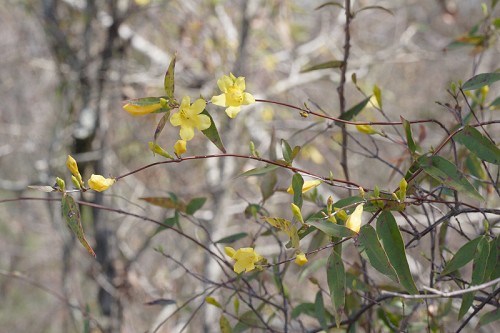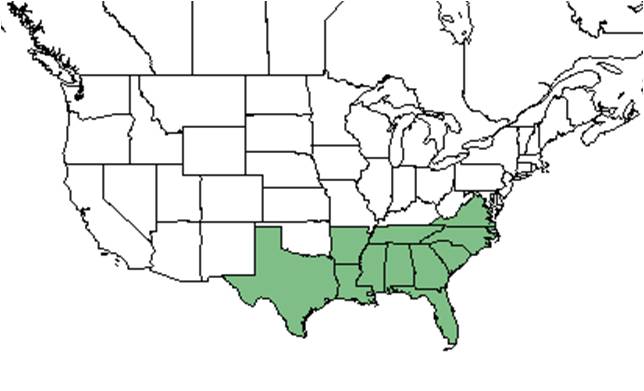Difference between revisions of "Gelsemium sempervirens"
Laurenloria (talk | contribs) (→Seed dispersal) |
Laurenloria (talk | contribs) |
||
| Line 29: | Line 29: | ||
==Ecology== | ==Ecology== | ||
<!--===Habitat===--> <!--Natural communities, human disturbed habitats, topography, hydrology, soils, light, fire regime requirements for removal of competition, etc.--> | <!--===Habitat===--> <!--Natural communities, human disturbed habitats, topography, hydrology, soils, light, fire regime requirements for removal of competition, etc.--> | ||
| − | + | ===Phenology=== <!--Timing off flowering, fruiting, seed dispersal, and environmental triggers. Cite PanFlora website if appropriate: http://www.gilnelson.com/PanFlora/ --> | |
| + | It flowers January to April with peak inflorescence in February.<ref>Nelson, G. [http://www.gilnelson.com/ PanFlora]: Plant data for the eastern United States with emphasis on the Southeastern Coastal Plains, Florida, and the Florida Panhandle. www.gilnelson.com/PanFlora/ Accessed: 9 DEC 2016</ref> | ||
===Seed dispersal=== | ===Seed dispersal=== | ||
This species disperses by gravity. <ref>Kirkman, L. Katherine. Unpublished database of seed dispersal mode of plants found in Coastal Plain longleaf pine-grasslands of the Jones Ecological Research Center, Georgia.</ref> | This species disperses by gravity. <ref>Kirkman, L. Katherine. Unpublished database of seed dispersal mode of plants found in Coastal Plain longleaf pine-grasslands of the Jones Ecological Research Center, Georgia.</ref> | ||
Revision as of 22:21, 9 December 2016
| Gelsemium sempervirens | |
|---|---|

| |
| Photo by John R. Gwaltney, Southeastern Flora.com | |
| Scientific classification | |
| Kingdom: | Plantae |
| Division: | Magnoliophyta - Flowering plants |
| Class: | Magnoliopsida - Dicotyledons |
| Order: | Gentianales |
| Family: | Loganiaceae |
| Genus: | Gelsemium |
| Species: | G. sempervirens |
| Binomial name | |
| Gelsemium sempervirens (L.) W.T. Aiton | |

| |
| Natural range of Gelsemium sempervirens from USDA NRCS Plants Database. | |
Common names: Evening trumpetflower; Yellow jessamine; Carolina jessamine
Contents
Taxonomic notes
Description
"High climbing or trailing vines, twining upward from left to right. Leaves evergreen, opposite, lanceolate to elliptic, 3-7 cm long, 1-2.5 cm wide, acute to acuminate, entire, base rounded to cuneate; petioles 2-7 mm long. Flowers actinomorphic, heterostylic, axillary, solitary or in cymes; pedicels short, bracteate. Sepals 5, separate to base, lanceolate,, 3-5 mm long, 1-2 mm wide; corolla 5-lobed, yellow, 2-3.8 cm long, the tube gradually flaring upward, lobes 7-10 mm long, spreading; stamens 5, attached to lower part of corolla tube, anthers sagittate; pistil 1, slender styled, 2-cleft, each divided again and appearing 4-cleft. Capsule compressed; seeds many, dull brown, the body roughly papillose." [1]
"Leaf base cuneate to rounded. Flowers very fragrant, usually solitary, rarely in 2-3 flowered cymes. Speals obtuse to subacute. Capsule oblong, 1.4-2 cm long, 0.8-1.2 cm broad, abruptly rounded to a beaked apex; seeds 0.7-1 cm long, membranously winged apically."[1]
Distribution
Ecology
Phenology
It flowers January to April with peak inflorescence in February.[2]
Seed dispersal
This species disperses by gravity. [3]
Pollination
The following Hymenoptera families and species were observed visiting flowers of Gelsemium sempervirens at Archbold Biological Station: [4]
Apidae: Bombus griseocollis, B. impatiens, Habropoda laboriosa
Conservation and management
Cultivation and restoration
Photo Gallery
References and notes
- ↑ 1.0 1.1 Radford, Albert E., Harry E. Ahles, and C. Ritchie Bell. Manual of the Vascular Flora of the Carolinas. 1964, 1968. The University of North Carolina Press. Print.
- ↑ Nelson, G. PanFlora: Plant data for the eastern United States with emphasis on the Southeastern Coastal Plains, Florida, and the Florida Panhandle. www.gilnelson.com/PanFlora/ Accessed: 9 DEC 2016
- ↑ Kirkman, L. Katherine. Unpublished database of seed dispersal mode of plants found in Coastal Plain longleaf pine-grasslands of the Jones Ecological Research Center, Georgia.
- ↑ Deyrup, M.A. and N.D. 2015. Database of observations of Hymenoptera visitations to flowers of plants on Archbold Biological Station, Florida, USA.